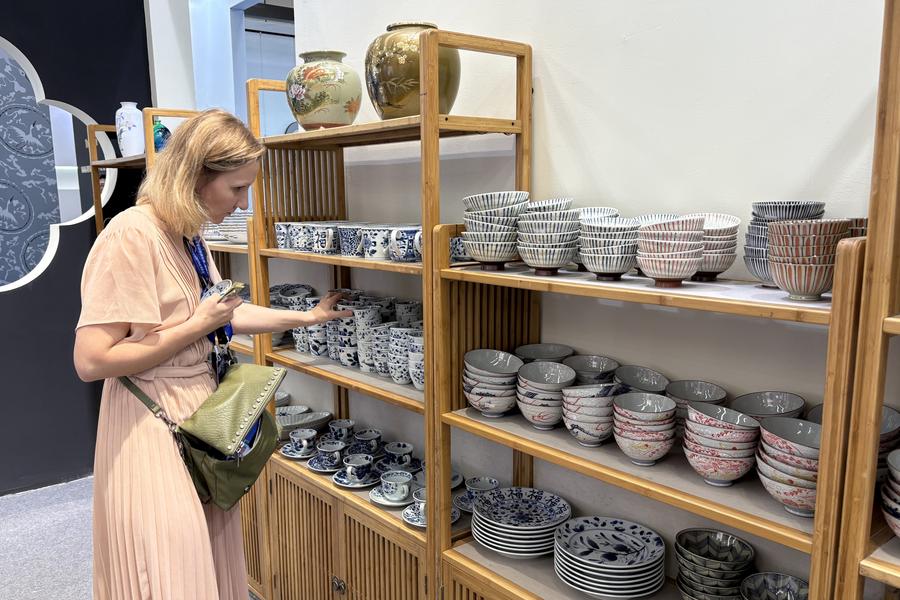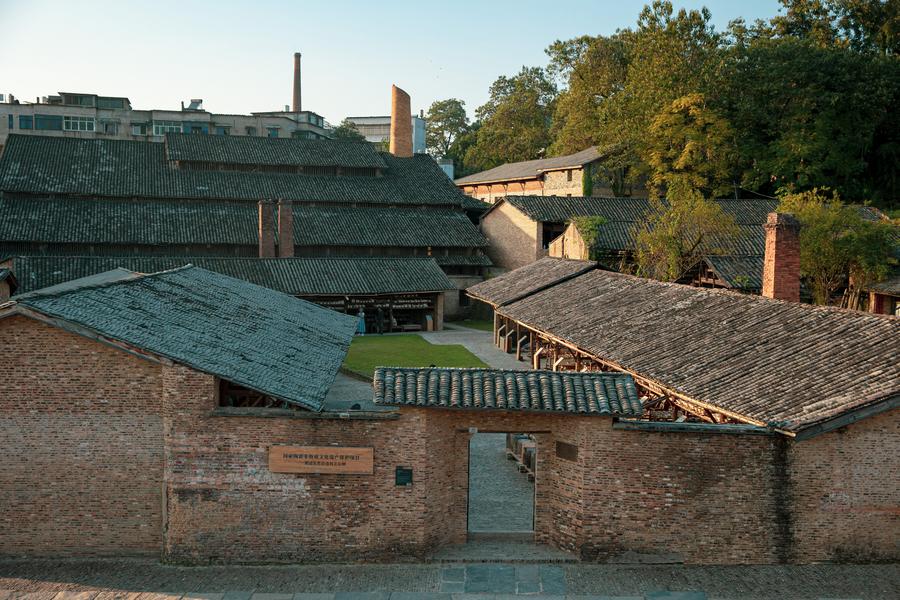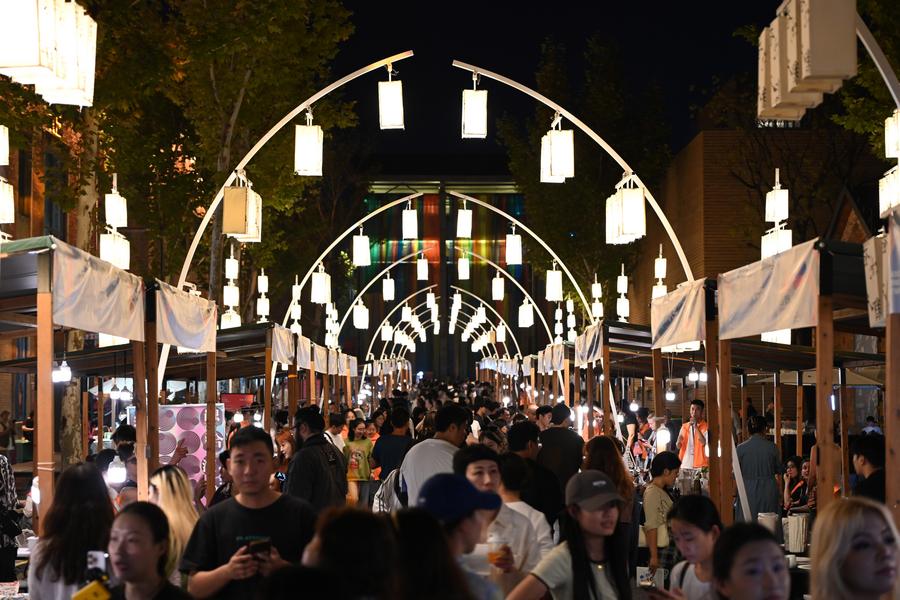* With over 2,000 years of history in ceramic craftsmanship, Jingdezhen has seen its streets shaped by the ceramic industry.
* The city is now home to nearly 1,900 intangible heritage inheritors, more than any other city in China, and its ceramic industry employs around 150,000 people, nearly a quarter of the urban population.
* With its growing appeal, the city has established friendly relations with over 180 cities in 72 countries, reinforcing its status as a hub for global cultural exchange.
NANCHANG, Oct. 28 (Xinhua) -- In the intense heat of a kiln in Jingdezhen, the "porcelain capital" in east China's Jiangxi Province, Liu Wen and his wife, Cheng Lihua, quietly watch as the clay transforms in the dance of the flames. The couple are inheritors of the high-temperature color glaze technique used in ceramics.
Their emerald-glazed coffee cups captured the interest of French distributors at the 2024 China Jingdezhen International Ceramic Expo that opened early this month and are set to soon embark on their journey overseas.
Two decades ago, Liu and Cheng founded the Jingdezhen Huayu Ceramics Academy to refine techniques and reduce the cost of high-temperature glazes. Today, the academy serves as a hub of innovation, having trained more than one hundred heritage inheritors and innovated over 20 patented techniques.
The couple, hailing from a vibrant community of artisans and craftsmen in Jingdezhen, is dedicated to preserving the city's millennia-old ceramic tradition while striving to foster this heritage on the world stage with a modern touch.
A guest selects porcelain products at the 2024 China Jingdezhen International Ceramic Expo in Jingdezhen, east China's Jiangxi Province, Oct. 18, 2024. (Photo by Li Yunhan/Xinhua)
PRESERVING MILLENNIA-OLD TRADITION
In his The Pilgrim Art: Cultures of Porcelain in World History, American scholar Robert Finlay wrote that over the next three centuries since the 16th century, 300 million pieces of Chinese porcelain, mostly produced in Jingdezhen, landed in Europe.
With over 2,000 years of history in ceramic craftsmanship, Jingdezhen has seen its streets shaped by the ceramic industry. At the heart of the city lies the Xujia Kiln, one of the oldest wood-fired kilns dating back to the late Ming Dynasty (1368-1644).
For 67-year-old Yu Xilai, an inheritor of the city's ceramic-firing techniques, the kiln represents more than bricks and mortar; it's a living testament to history.
Yu started working at Xujia Kiln at 14, following in his father's footsteps. However, upon returning to the site 12 years ago, he confronted a haunting sight with the kiln in ruins, forgotten and crumbling.
"There was nothing but broken bricks and collapsed walls. I thought to myself, if we don't act now, this piece of history will vanish forever," Yu said.
Fueled by a passion for preserving Jingdezhen's history, Yu and his colleagues secured funding through a national initiative for intangible cultural heritage. The reconstruction involved the meticulous crafting of 150,000 bricks over three months, with many elderly artisans leaving their well-paying jobs to assist in the effort.
A kilns cluster, where Xujia Kiln is located, is pictured at Taoyangli historical and cultural block in Jingdezhen, east China's Jiangxi Province, May 31, 2024. (Xinhua)
Today, the names of these artisans are etched into the kiln bricks, forever woven into the fabric of this historic site. "Some of those craftsmen have passed away, but their names live on," Yu said. "They are now part of the kiln's enduring story."
The city is now home to nearly 1,900 intangible heritage inheritors, more than any other city in China, and its ceramic industry employs around 150,000 people, nearly a quarter of the urban population.
HUB FOR INNOVATION, CULTURAL EXCHANGE
As night descends, the Taoxichuan Ceramic Art Avenue in Jingdezhen comes alive, bustling with ceramic artists, young entrepreneurs, live streamers and curious visitors exploring over 1,000 stalls.
In recent years, Jingdezhen has become a melting pot of innovative ideas with over 25,000 young creators registered in Taoxichuan since 2016.
Yang Fan, from central China's Hubei Province, is a frequent vendor at the market, offering stylish jewelry that blends traditional ceramics with modern designs.
"Creative products are key to capturing the attention of young consumers. For ceramic products to remain popular, they must continue to incorporate new elements and align with evolving trends," she said.
People visit the Taoxichuan Spring & Autumn Art Fair in Jingdezhen, east China's Jiangxi Province, Oct. 17, 2024. (Xinhua/Zhu Yunuo)
The city has also attracted many artists as well as merchants from other countries, who have helped spread China's ceramic culture to the world and make the city better known internationally.
Among them is Park Ju-hee, 45, from the Republic of Korea, who has settled in Jingdezhen to pursue her dream.
"Jingdezhen is renowned for its rich ceramic heritage and its favorable entrepreneurial environment," she said. "It's a perfect place for artistic creation."
With its growing appeal, the city has established friendly relations with over 180 cities in 72 countries, reinforcing its status as a hub for global cultural exchange.
For instance, the opening of the Jingdezhen ceramic flagship store in Dubai in late 2023 has helped 173 local ceramic enterprises go global.
Last year, Jingdezhen's ceramic exports more than doubled from the previous year to over 1 billion yuan (about 140.24 million U.S. dollars), reaching 53 countries and regions.
"Jingdezhen is not only preserving its legacy but also becoming a vibrant center for cultural dialogue and exchange between East and West," Cheng said.
(Reporting by Ma Xiaoran, Huang Haoran, Zhu Yunuo; Video reporter: Zhu Yunuo; Video editors: Zhang Yucheng, Zhao Xiaoqing, Zhang Yueyuan)







 A single purchase
A single purchase









